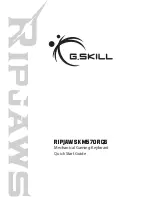
10-222
KDFX Reference
KDFX Algorithm Specifications
959 2 Band Enhancer
2 band spectral modifier
PAUs:
1
The 2 Band Enhancer modi
fi
es the spectral content of the input signal primarily by brightening signals
with little or no high frequency content, and boosting pre-existing bass energy. First, the input is non-
destructively split into 2 frequency bands using 6 dB/oct hipass and lopass
fi
lters (Figure 1). The hipassed
band is processed to add additional high frequency content by using a nonlinear transfer function in
combination with a high shelving
fi
lter. Each band can then be separately delayed to sample accuracy and
mixed back together in varying amounts. One sample of delay is approximately equivalent to 20
microseconds, or 180 degrees of phase shift at 24 khz. Using what we know about psychoacoustics, phase
shifting, or delaying certain frequency bands relative to others can have useful affects without adding any
gain. In this algorithm, delaying the lopassed signal relative to the hipass signal brings out the high
frequency transient of the input signal giving it more de
fi
nition. Conversely, delaying the hipass signal
relative to the lopass signal brings out the low frequency transient information which can provide punch.
The transfer applied to the hipass signal can be used to generate additional high frequency content when
set to a non-zero value. As the value is scrolled away from 0, harmonic content is added in increasing
amounts to brighten the signal. In addition to adding harmonics, positive values impose a dynamically
compressed quality, while negative values sound dynamically expanded. This type of compression can
bring out frequencies in a particular band even more. The expanding quality is particularly useful when
trying to restore transient information.
Parameters
Page 1
Page 2
In/Out
When set to “In” the effect is active; when set to “Out” the effect is bypassed.
Out Gain
The overall gain or amplitude at the output of the effect.
CrossOver
Adjusts the -6dB crossover point at which the input signal will be divided into the hipass
band and a lopass bands.
Hi Drive
Adjusts the gain into the transfer function. The affect of the transfer can be intensi
fi
ed or
reduced by respectively increasing or decreasing this value.
Hi Xfer
The intensity of the transfer function.
Hi Shelf F
The frequency of where the high shelving
fi
lter starts to boost or attenuate.
In/Out
In or Out
Out Gain
Off, -79.0 to 24.0 dB
CrossOver
17 to 25088 Hz
Hi Drive
Off, -79.0 to 24.0 dB
Hi Xfer
-100 to 100%
Hi Shelf F
16 to 25088 Hz
Hi Shelf G
-96 to 24 dB
Hi Delay
0 to 500 samp
Lo Delay
0 to 500 samp
Hi Mix
Off, -79.0 to 24.0 dB
Lo Mix
Off, -79.0 to 24.0 dB
Summary of Contents for K2661
Page 18: ...2 4 LFOs LFO Shapes...
Page 34: ...3 16 DSP Algorithms...
Page 54: ...5 4 MIDI Note Numbers Note Numbers for Percussion Keymaps...
Page 72: ...7 10 System Exclusive Protocol K2661 System Exclusive Implementation...
Page 82: ...9 4 Upgrading Sample Memory Choosing and Installing a SIMM for K2661 Sample Memory...
Page 334: ...10 252 KDFX Reference KDFX Algorithm Specifications...
Page 340: ...11 6 Glossary...
Page 382: ...12 42 Triple Modular Processing Alphanumeric Buttonpad Entries for DSP Functions...
Page 392: ...B 6 SysEx Control of KDFX MSB and LSB...
Page 442: ...D 20 Contemporary ROM Block Objects Controller Assignments Contemporary ROM Block...
Page 490: ...H 12 General MIDI Standard Mode Controller Assignments...
Page 492: ...I 2 Live Mode Objects Live Mode Programs...
Page 498: ...K2661 Musician s Reference Index...
Page 500: ......
















































